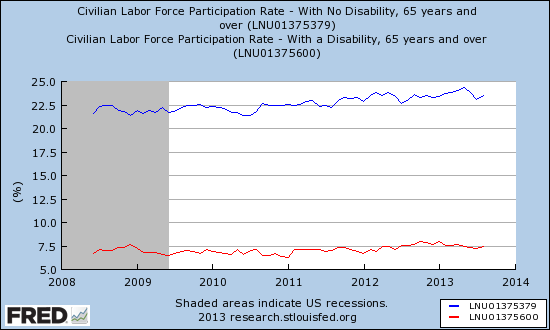(This is an excerpt from an article I originally published on Seeking Alpha on September 22, 2013. Click here to read the entire piece.)
In his opening statement for his press conference following the latest meeting of the Federal Reserve, Chairman Ben Bernanke once again called out the influence of lower participation rates on unemployment… {snip}
{snip}
So is the decline in participation in the past year an unfavorable development or not? In the above response, Bernanke did an about face by contradicting his apparent lament in the opening statement that this 0.3 percentage decline is “not a positive development” in the labor force. {snip}
This topic caught my interest particularly because I have seen many pundits, bloggers, and the like decry any improvement in employment because of the decline in the participation rate. They rarely acknowledge the structural component of this decline that has little to nothing to do with the recession; this decline will likely continue even once the labor market firms up. {snip}
{snip}

{snip}

{snip}

{snip}
Regardless, any way the data are sliced, the structural issues are evident in the labor force participation rate. Still, some are, strangely enough, worried that the unemployment rate will increase once the labor market shows substantial improvement. This concern is directly related to the knock that the unemployment rate would be much higher if the participation rate were higher. Staff economist Andreas Hornstein at the Federal Reserve Bank of Richmond is working on some important insights on this question that could potentially turn conventional thinking on its ear. {snip}
{snip} Hornstein’s analysis of the labor flow data, isolating cyclical and structural (trend) features, show that a high unemployment rate induces a higher likelihood that participants will enter the labor force as unemployed and a lower likelihood that that they exit the labor force from an unemployed state. Thus, the unemployment rate and the participation rate increase together. The observed negative correlation between these rates is entirely explained by the decrease in likelihood that a participant directly transitions from inactivity to employment.
{snip}
Be careful out there!
(This is an excerpt from an article I originally published on Seeking Alpha on September 22, 2013. Click here to read the entire piece.)
Full disclosure: no positions
